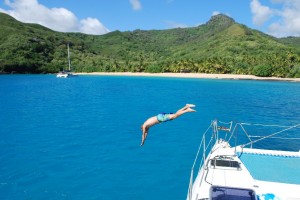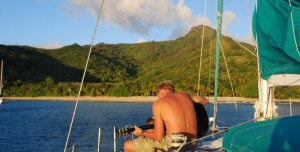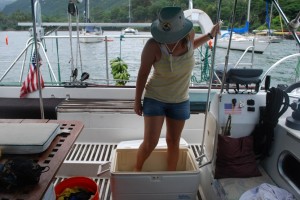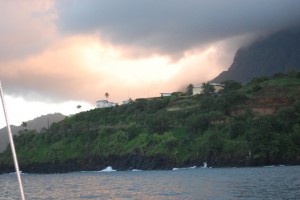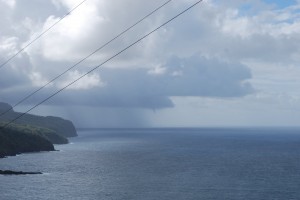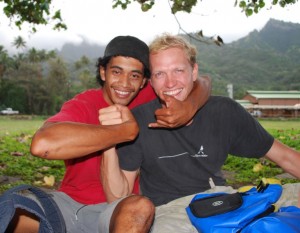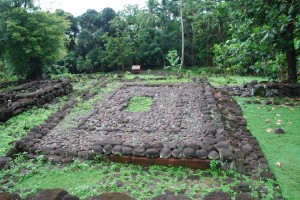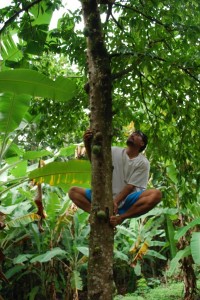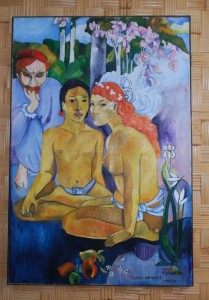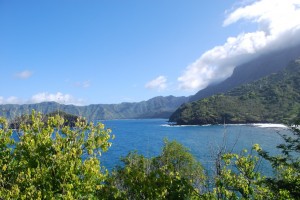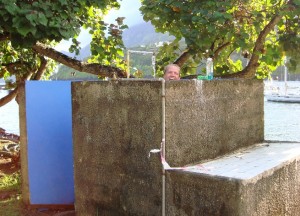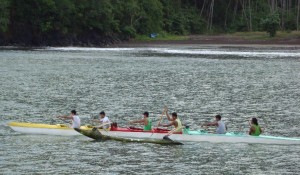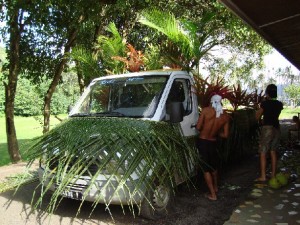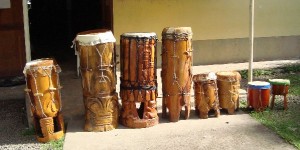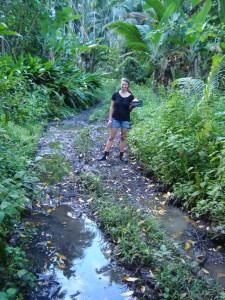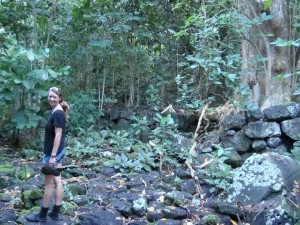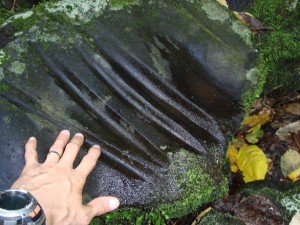About noon today, preparations were finally complete, the stern and bow anchors had been hoisted, and we left Hiva Oa and Taahuku Bay. We motorsailed west through Bordelais Channel and then headed south to sail along the west coast of Tahuata. We didn’t know precisely where we were headed, but we decided on the way to have a look at the bays on the northwest portion of the island, to stay if we liked them, and to head to the bays farther south if we didn’t. We lost our cruising guide to French Polynesia somewhere between Panama and the Galapagos, but Paul on Disa (the Swedish boat) had the same book as well as a cruising guide just for the Marquesas. We borrowed them for a couple of days, took some notes, and then photographed every page of interest. Cruisers are generally short on cash and even less able to take advantage of cheap and timely mail services, so things like charts, CDs, DVDs, and books are copied and shared freely (we just loaded up Paul’s 500 GB hard drive with movies yesterday). This all resulted in Lauren holding the Nikon and using its picture-viewing screen to zoom in and read photographed cruising guides out loud as we sailed by the bays she was describing.
We really wanted to enjoy a clear bay and we’d heard Hanamoenoa recommended by a couple of people. When we saw the water color lighten to a light turqoise and then break onto a sandy beach backed by coconut and lime trees we decided to turn in. We furled the jib and headed in. We knew there were some coral heads, so I walked to the bow to prepare the anchor to watch the water and point the way to Wes, who was at the helm. As I started walking forward I noticed I could already see the bottom very well and asked Wes what the depth was. “40 feet,” he answered. I hollered back that I could already see the bottom and everyone was excited. This was Bahamas water! Wes pulled out the snorkel gear and I changed into a swimsuit and headed for the bow. There’s only one thing to to on a warm afternoon when you’re anchored in clear water for the first time in forever — dive in.
Tiff and Lauren followed me and soon we were all in the water with snorkeling gear. The bottom wasn’t near as bad as I thought, which is good news (but not as good as Wes volunteering to clean it tomorrow). The rudder damage from the fishing line caught on the prop during our last passage looks worse than I remember and the underwater camera is only taking pictures above water, but c’est la vie. On our way to check the anchor we swam over a 4-5 foot stingray just resting on the bottom and soon after that we found two about the same size laying on the bottom right next to each other. We saw several fish, but the water was still a little deep for us and didn’t have many heads so we started swimming toward the cliffs on the south side of the bay. Both the north and south side of the anchorage are lined with small volcanic cliffs. You can see the lava folds in many places and in a few others you can see the red rocks characteristic of oxidized iron. On the way, Wes spotted a small octopus that quickly disappeared in to a hole the rocks. I’ve only seen one octopus underwater. An octopus moving through the water around a coral head is a really weird sight, much stranger to me than seeing an eel, and they seem to be pretty shy.
The coral near the cliffs didn’t seem to healthy, but there was no shortage of it and we saw a lot of interesting and colorful small to medium-sized fish. We’re pretty familiar with most of the fish of Florida and the Bahamas, but we all saw some new fish today. The underwater camera wasn’t working, so as inadequate as my descriptions are, I’ll mention a few. There was a small fish about 4 inches long that was an extremely bright, vivid orange with flourescent blue rings around it’s eyes, and lines of the same color along it’s gills and tail. Wes and Tiff spotted a rainbow-colored fish with stripes including green, yellow and purple among other colors. There was a thin, round fish about 10 inches long with an alternating black and yellow stripe pattern in a large circle around the edge of it’s body; its sides were a pale color witih diagonal burnt orange stripes. We saw a very long thin fish that looks like the trumpet fish we’re familiar with, but instead of being fairly boring in marking, it was very dark with a black and yellow tail that also had spots arrayed across it. There was also something that looked was shaped a lot like an angelfish but had an orange body, a black head area, and a very long nose (roughly 14 inches overall with 3 inches of nose not more than a centimeter wide). Lauren’s snorkel broke and she also lost a fin when a wave swept her off while trying to climb a cliff, but other than that it was good times.
We swam to the boat in time to relax for a while before sunset and watch the four young children from the three other boats anchored here playing in the surf on the beah while the adults walked the beach and hung out in the shade. The bay is open to the west, so we saw our first sunset into the ocean in a week or so. It was a good one. There was a low layer of clouds that kept us from seeing the sun slip into the water, but the sky above them was a soft orange that faded into light peach, followed by broad area of pink, and then finally the twilight blue of the larger sky. Right as the sun was setting, people from the two boats here that we hadn’t met before came by in their dinghy to say hi and welcome us to “the most beautiful bay in the Marquesas.” They’re both Americans (the first we’ve seen in a while). The large, beautiful mono Uliad is from Minnnesota and the catamaran Independence is from New York.
There’s really no excuse not to give the girls a break from cooking when we’re at anchor and there’s a nice breeze blowing. The wind blows down pretty forcefully off of the small mountains behind the beach which is a really nice change — the boat is cool, the wind generator is keeping the batteries topped off, and we’re riding nicely to our anchor, especially with the swell being blocked by the island. I volunteered for galley duty tonight and made pasta with a caramelized onion and mushroom alfredo and cheezy garlic bread. We’ve been away from cheap supermarkets for about 6 weeks now and although we have plenty of food, we’re staring to be a little more dependant on what’s available locally. For lunch we had veggie burgers on baguettes with a salad of local Chinese cabbage, tomato, and onion. Instead of croutons we had some French’s fried onions (the ones that are used on green bean casserole) that are part of the food still left from the US.
With plenty of power from the wind generator we were able to listen to some great music while eating dinner. The only ambient light in the bay was from 3 anchor lights (for some reason, in the last two anchorages only the the American boats have used anchor lights) and with no clouds the sky was full of stars.
When I saw the relatively small size of this bay, I was surprised that when I asked him abot the Marquesas, Jeff on S/V Stravaig had been able to remember the location and the name Hanamoenoe off of the top of his head years after last sailing the Pacific. After less than a day here I now understand why.
Today’s news is pretty mundane compared to the last blog. It rained off and on until the early afternoon, but we still managed to get a few things done. The girls went to town in the morning to get some groceries, and I replaced a section of wire for the red port running/navigation light that had gotten too dim to see during our passage. The original wiring from 1989/1990 used non-tinned copper wire and some of the more exposed sections have had to be replaced. The individual copper strands in the wire become covered in black with what I’m assuming is galvanic corrosion. Many of the more exposed wires that are working fine need to be “shined” with sandpaper before the solder will stick to them. Wes was also able to get the water pump working properly today. For the last week or so, it hasn’t shut off on its own, so we’ve had to only turn it on when we need to use a faucet. The pump is responsible for pumping fresh water from our tanks and keeping the water pressure similar to a typical house in the US. When all the faucets are off, it should turn off within a minute or so, after increasing the pressure in the water lines to a preset amount. Unfortunately, it hasn’t been shutting off, and Wes had already tried replacing the pump with one of the used spares that was aboard the boat when we bought it. After a fair amount of work over the last couple days, he was able to isolate the problem to an intake hose and things are working fine now.
This afternoon Tiff & Wes made their first attempt at doing laundry ourselves sans washing machine or drier. The Swiss woman here in the anchorage told us her favorite method was to use her feet, standing in a cooler or bucket of clothes and water/detergent then stomping around a bit — like a washing machine she said, with the added bonus of very clean feet when you’re done. Tiff tried a similar method and in half an hour or so, she and Wes had their laundry hanging up on the lifelines around the boat. The sun and wind didn’t cooperate and dry them quickly, but they seemed to do pretty well for the first attempt. Lauren and I will be in for our first attempt sometime in the next few days.
Lauren and I had a shower tonight (still getting used to having an unlimited running water shower nearby), which is generally not an extremely noteworthy event, but if you remember the shower here, it’s just a concrete box in the shape of the number 9 with a clothes-washing shelf as part of the same structure. The French couple with the child that’s almost two came up and were washing some clothes while waiting for a shower. They’re really nice, speak a little bit of English, and just left from France last December. The funny part is that I’m having this conversation with them while Lauren is in the “shower”: about 2 feet away. Then it’s my turn for a shower, and I listen to and watch the nice conversation Lauren is having while I’m enjoying the cold water from the pipe in the dim glow from a parking lot lamp nearby. Just another one of those random things that would be so out of place in the states but is as normal as can be out here.
Because it’s fairly easy here, we’ve stocked up on water even though people are saying the quality isn’t very good. We’ve had no problems yet. Wes pours the water into the tanks through a sediment filter that traps any big stuff (you’d be surprised) and then treats the water with chlorine to kill the nasties. An in-line charcoal filter then does a pretty good job of taking out the rest of the junk and the chlorine taste. Such is life these days. I remember when all I had to do was put the glass under the faucet and turn the knob. Cruisers talk about some funny things, and water is actually one of the interesting ones here in the Marquesas. It’s plentiful because the high islands induce a lot of rainfall, and in some of the bays you can walk to waterfalls or pristine streams in now-uninhabited valleys that provide what we’ve heard is some of the best tasting water in the world. With such interesting and pure water sources available, people are always discussing whether to use the tap water here or there or to hold out until they’re in such and such bay and then lug their water jugs to the “good water”. Between here and the Galapagos, we’ve carried the 50-pound water jugs enough already to prefer the short walk with a dose of chlorine.
One of the things here that the cameras don’t seem to do a good job with is the clouds around the mountain peaks. It’s hard to describe, but almost mesmerizing to watch sometimes. My favorite is when the bottom of the clouds is near the top of the mountain and there a good wind blowing. The thin clouds sweep and churn around the jagged peaks like some sort of fluid dynamics experiment. Clouds usually look pretty boring, but when you see them interact with something as large a mountain top, they really become more dynamic and their varying character over the day become much more noticeable. The larger mountains are to the west of us and the last couple of nights at sunset, the clouds have dropped lower down the mountainsides and the sun turns them a dusky orange in places. It really looks like half the island is on fire The only similar thing I’ve seen is wildfires in California. On a final cloud note, on the drive to Taaoa yesterday, we saw the beginnings of a waterspout coming down from a thick heavy cloud that was hovering over the south coast of Hiva Oa. Waterspouts are the marine version of a tornado, but they’re not nearly as dangerous. They’re generally much weaker and short lived and often never touch down, but they are interesting to see.
Tomorrow we’re planning to leave Taahuku Bay and head for Tahuata, which is the island just south of Hiva Oa. We’ve heard about a clear bay that would be good for diving or snorkeling, there are artisans on the island who carve wood and bone that is usually sold in Tahiti, and there is a bay with an interesting history related to Captain Cook stopping there and the French choosing to declare possession of the Marquesas there as well. After that, we’re probably going to stop in one of the uninhabited bays on the north side of Hiva Oa before heading to the island of Ua Pou. I’m not sure what the internet situation is going to be like there, but it probably won’t be great, so we may be back to sat phone blogs and no pics for a while.
We took a walk down to the beach and found many young people who were also drinking beer. Befriending them was pretty effortless at this point, probably thanks to the beer. Also, only a handful of Americans sail here each year, and very few of them of are as young as we are. The language barrier was a little prohibitive, but we did pretty well. Each day I find myself recalling more French vocabulary that I learned in college, which is fortunate, as there are very few Marquesans that speak English at all. In fact, one of the more intoxicated fellows kept referring to Dallas as his “boyfriend” until we explained to him what that means.
From the beach we walked up the hill to the hotel nearby and had some pizza that was only fair. I have been eying the poisson cru on the menus but have been too cheap to try it. However, we found out today that Tim is treating us to yet another meal, so next time I’ll be having the tuna poached in coconut milk!
This morning we awoke to find that Alec was waiting for us with his truck on the quay. We had not made any particular arrangements with him, except to tell him that we had decided to take him up on his offer to give us a tour of the ancient ruins, so there he was. We hopped in his pick-up and rode up the volcano to nearby Taaoa. He told us that he was taking us to see the marae, the place where the ancient (pre-1800) Marquesans used to congregate to perform rituals to please the gods. I was expecting there to be a few rocks arranged deliberately with a tiki carving thrown in, but instead, we were able to see a completely intact tahoa, the area where they danced for the gods. We sat in the very place where the chief used to sit in his recliner made of rock. It was simultaneously eery and awesome (in a historical sense) to be in the very place where they used to perform human sacrifices, believed to be the most generous gifts they could give to the gods. Alec showed us the one-person prison of rock where they kept the unfortunate man or woman who was to be the gods’ gift, and subsequently, the gourmet dinner for the evening. Can you imagine? Alec seemed to think this part of his heritage was really funny!
In addition to the archeological significance of the site, there were trees of all sorts. Alec pointed out various fruit trees such as papaya and breadfruit as well as coffee bean and a nut tree with a name I can’t recall. He climbed a tall curasel (sp?) tree in less than a minute to retrieve for us a soft, green fruit with a strange flavor kind of like a pear. Other trees that he pointed out are used for medicinal purposes, clothing, or decoration. It seems that every tree has some practical value for the Marquesans.
Alec also took us to a couple of ancient cemetaries, one of which contains the grave of Paul Gauguin, the French impressionist painter who is now famous for his depictions of Tahitians and Marquesans. We went to the Gauguin museum after our tour with Alec and saw some of these pieces. The story of his life is said to be ironic in that he was not very well liked in either France or the Marquesas but became renowned all over the world after his death. In fact, when an American came here looking for his grave, the Marquesans were surprised to learn he was famous. They wished that they hadn’t leveled his house and lost his remains! Apparently they found where he was buried, moved him to the big gravesite overlooking the bay, and have built progressively more decorative tombs for him over the last 100 years.
After a very interesting day, we walked back to the anchorage in time to meet Alec’s wife who brought some fruit that we requested. We have been envious of our neighbors’ stalks of bananas hanging in their cockpits but now have one of our own. We also have some pampelmousse, which is very similar to but less tart than grapefruit.
In addition to these amazing experiences, we have seen some truly awesome landscapes. Today was really clear with the exception of a very brief rainstorm the came through (that Alec heard coming long before it arrived). You have to see the pictures to really get a sense of the Marquesas, and fortunately, Wes has been able to upload all the photos we’ve taken so far. We took over 400 photos today, but he has pared them down and organized them for your viewing pleasure. Enjoy! ;-)
Next, we stopped at the tourism office (first time we’ve seen it open) and found several leaflets in English about the culture of French Polynesia and met a nice guy who explained several of the archaeological sites around the island to us in Frenglish (mostly French, but with some English nouns and the verb “is”, which in Frenglish is pronounced “eez”). Armed with his information on sites, trails, and bays, we hope to be more productive in our sightseeing than Lauren and I were the other day.
We made a couple of stops in stores while waiting to drop off some laundry (about $4.00 to wash and dry a kilo!) and checked out local prices. $6.00 for one roll of paper towels was our favorite overpriced item, while $9.45 for 12 hamburger patties seemed pretty reasonable. After searching the store, we found a few cheap items that we bought to sample, including a nice package of crackers and a small block of no-refrigeration cheddar cheese for less than $2! The cheese turned out to be good, so we’ll definitely be back for more.
When we returned to the anchorage, it was shower time! While we were waiting for our turn in the shower, we struck up a conversation with some other cruisers there on the quay. The couple from the Brazilian boat, Matajusi, was very friendly and the man had lived in Houston for 4 years and Boston for 15 years. The couple from the unmarked boat also came ashore and turned out to be a nice French couple with a small girl. They speak some English and both boats had just come from Fatu Hiva. They called Atuona, with its population of 2,600 or so “big” and had some great stories about trading for fruit in less populated bays of Fatu Hiva.
The locals keep racing outrigger canoes here by the anchorage and use the small bay as a practice area. They come out in the evenings and practice in either a one-person outrigger or one of the larger 5-6 person outriggers. We were launching our dinghy to go back to the boat right as a group in a 6-person canoe was coming it. Their paddle handles are short with a wide paddle area that is swept back 10-15 degrees or so from the handle to provide a better angle with the water. It’s fun to watch them accelerate quickly across the bay and to see teams of canoers paddle in unison. It’s very similar to the style of the Hawaiians that we got to see a couple of years ago.
On our way back to the boat in the dinghy we stopped and invited the Swedish couple Paul and Eng-a-lee over for dinner. We had hamburger patties and they had baguettes, so it was a perfect match. It also turns out that Paul is a vegetarian as well, so we had two sets of veggie patties. We swapped stories of our passages and boat repairs. They’re short of good books, which is a very painful thing at sea, so we dug through or library and gave them some classics that we’d already read. Despite the humorous sight of a nice hamburger patty sitting between two small slices of baguette, the food was delicious and we thoroughly enjoyed ourselves.
Today is a big holiday in town — Bastille Day. The locals don’t care too much about the details of French history, but like everyone, they do love a good excuse for a celebration. Although the larger festivities are in Nuku Hiva, there are going to be traditional drummers and dances that we’re anxious to see. We pass by their practice area on the walk into town and got a couple pictures of them decorating a truck with coconut tree leaves. Their traditional drums, pahu, were standing nearby. The drums are made form a single piece of wood, with sides featuring a variety of carvings and the bottom portion formed into a base.
This all looked straightforward and interesting, so we set off. There was a big sign where the dirt track split off of the main road indicating that it was indeed the way to the petroglyphs. So far so good.
Before too long, the road became muddier and muddier until Lauren was stopping every 50 feet or so to repair her flip-flop. She put on her scuba booties, which we’d brought for walking in the creek and we began to move much quicker. We continued plodding in through muddier and muddier conditions for about an hour. We nearly turned around a couple of times, but after an hour of walking through a weedy and muddy road, you really want it to be worthwhile, so we kept going. Finally, we came to the part of the road that crosses the river and with a clearing of coconut and banana trees on the other side. This was exactly what the map had shown, which was pretty exciting. There had been no signs since the one at the main road, and it was becoming clear that this was a very seldom used track into the interior, as the weeds were high in the middle of the road and the agricultural area didn’t seem to be actively worked anymore. After the farm, our recollection of the map was fuzzy, and we initially followed a couple of dead ends. Eventually, we started up the opposite side of the valley on a “path” that was overgrown with weeds and brush about 2-3ft high (just couldn’t get enough, I guess).
After following this for a while we came to what used to be a clearing but was now a thicket of weeds and brush, much of it 5-6ft tall. At the edge of this area, however, was a tourist-type sign for the Petroglyphs of Tehuete, with a description in French and English! We had a actually found it, but there was nothing to see except the sign. We weren’t ready to give up so easily, and after looking around we eventually noticed that through the thicket and a stand of trees on the other side, a bit of a man-made wall could be seen. Eventually we made our way over and did get to see some old ruins. They were under a canopy of very large trees not too far from the base of a large steep cliff that rises from the valley floor almost vertically to the peak of a mountain above. The ruins were a sort of terrace with made of about 3 levels. The walls and “paved” area of the terrace were made of volcanic rocks of greatly varying sizes. Some were less than a foot in diameter and some were large boulders 5 feet or more across. They were fitted together to form the structure, but without any mortar or cement. We didn’t find the two stone carvings that the sign indicated were present (my guess is they’re in a museum somewhere and nobody visits this site anymore), but we did find several large rocks that looked like they had been used as workbenches for many years. They had smooth shapes ground into them that seemed to come from repeatedly rubbing or grinding something against them.
It was less than a couple of hours from sunset, so we reversed our path, stopping at the stream to cool our muddy and itchy legs and have a drink of water. When we arrived back at our anchorage, three more boats had come in. There are now six of us here — 1 US, 1 Swedish, 1 Swiss, 1 French, 1 Brazilian, and one boat with a stalk of bananas instead of a flag and only a portion of the name and hailing port left on the stern.
This morning we’re off to try to check in and then we’ll try out the “shower” for cruisers on the dock here. It has unlimited water, but not hot and not exactly the Ritz. Maybe more of a step sideways than a step up, but we’re looking forward to it (shower pic later today…).



